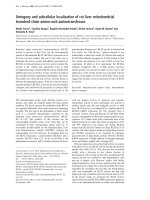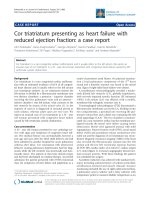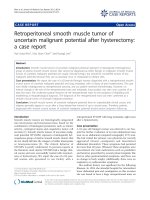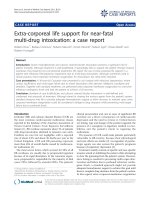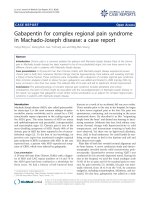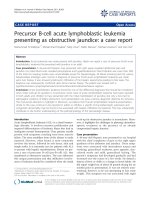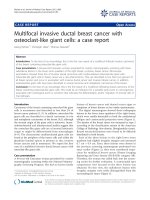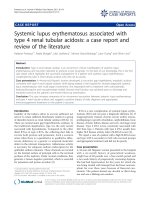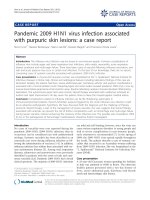Báo cáo y học: " Retroperitoneal smooth muscle tumor of uncertain malignant potential after hysterectomy: a case report" docx
Bạn đang xem bản rút gọn của tài liệu. Xem và tải ngay bản đầy đủ của tài liệu tại đây (4.85 MB, 6 trang )
CAS E REP O R T Open Access
Retroperitoneal smooth muscle tumor of
uncertain malignant potential after hysterectomy:
a case report
Hye Sung Won
1
, Hoo Geun Chun
2*
and Kyungji Lee
3
Abstract
Introduction: Smooth muscle tumors of uncertain malignant potential represent a histologically heterogeneous
group of uterine smooth muscle tumors that cannot be diagnosed as either benign or malignant. Smooth muscle
tumors of uncertain malignant potential are usually clinically benign, but should be considered tumors of low
malignant potential because they can occasionally recur or metastasize to distant sites.
Case presentation: We report the c ase of a 62-year-old Mongol woman diagnosed with a retrope ritoneal smooth
muscle tumor of uncertain malignant potential and lung metastasis, with a history of prior hysterectomy. The case
was initially misdiagnosed as retroperitoneal sarcoma, and our patient received chemotherapy. However, no
interval change in the size of the retroperitoneal mass and metastatic lung nodules was seen over a period of at
least five years. She underwent partial resection of the retroperitoneal mass for the purposes of debulking and
establishing a histopathological diagnosis. The diag nosis of the retroperitoneal mass was then confirmed as a
smooth muscle tumor of uncertain malignant potential.
Conclusion: Smooth muscle tumors of uncertain malignant potential have an unpredictable clinical course, and
relapses generally appear to occur after a long disease-free interval of up to several years. Therefore, patients
diagnosed with smooth muscle tumors of uncertain malig nant potential should receive long-term follow-up.
Introduction
Smooth muscle tumors are histologically categorized
into leiomyomas and leiomyosarcomas, based on the
combination of histological parameters such as mito tic
activity, cytological atypia and coagulative tumor cell
necrosis [1]. Smooth muscle tumors of uncertain malig-
nant potential (STUMPs) represent a histologically het-
erogeneous group of uterine smooth muscle tumors that
do not clearly fall into the category of either leiomyomas
or leiomyosarcomas [2]. The clinical behavior of
STUMPs is poorly understood. I n previous reports in
the literature, most uterine STUMPs had a benign clini-
cal course and were successfully treated with myomect-
omy or hysterectomy. We report the case of a 62-year-
old woman who presented to our facility with a
retroperitoneal STUMP with lung metastasis, eight years
after a hysterectomy.
Case presentation
A 62-year-old Mongol woman was referred to our hos-
pital for further evaluation of an intra-abdominal mass
seen on an abdominal computed tomography (CT) scan.
She had visited her primary care physician for recently
aggravated chronic constipation and intermittent
abdominal discomfort. These symptoms had persisted
for more than 20 years. Whenever these symptoms were
exacerbated, she took medications such as painkillers
and laxatives prescribed by several private hospitals. She
had no other gastroint estinal symptoms, and there was
no change in body weight. Additionally, there were no
respiratory or cardiovascular symptoms.
Her medical history was significant for the following
illnesses. In 1994, she attended hospital for intermittent
lower abdominal pain and constipation; on this occasion
she was found to have a large retroperitoneal mass on
* Correspondence:
2
Division of Medical Oncology, Department of Internal Medicine, Seoul St
Mary’s Hospital, Seoul, Korea
Full list of author information is available at the end of the article
Won et al. Journal of Medical Case Reports 2011, 5:214
/>JOURNAL OF MEDICAL
CASE REPORTS
© 2011 Won et al; licensee BioMed Central Ltd. This is an Open Access article distributed under the terms of th e Creative Commons
Attribution License (http://creativec ommons.org/licenses/by/2.0), which permits unrestricted use, distribution, and reproduction in
any medium, pro vided the original work is properly cited.
an abdominal CT scan. Additionally, a chest CT scan
showed small, well defined nodular lesions in both per-
ipheral lung fields. A sonography-guided fine needle
aspiration biopsy of the retroperitoneal mass was per-
formed. The cytological findings revealed an atypical
spindle cell tumor, and differential diagnoses of malig-
nant fibrous histiocytoma, leiomyosarcoma, fibrosar-
coma and malignant schwannoma were considered. At
that time, she was diagnosed with retroperitoneal sar-
coma with lung metastases. She received six cycles of
ifosfamide (1440 mg/m
2
on days one to five) and etopo-
side (80 mg/m
2
on days one to five). After completion
of the planned chemotherapy, there were no significant
interval changes in the size of the retroperitoneal mass.
Additionally, she received six cycles of CYVADIC
(cyclophosphamide 500 mg/m
2
,doxorubicin50mg/m
2
,
vincristine 1.5 mg/m
2
on day one, dacarbazine 250 mg/
m
2
on days one to five) chemotherapy. She was t hen
lost to follo w-up and had received no further treatment
since then.
In November 2005 and January 2007, she visited the
Department of Respiratory Medicine at our hospital due
to symptoms of upper respiratory infection. She und er-
went abdominal and chest CT s cans on both these vis-
its. Between 2005 and 2007, her CT findings showed no
significant change in the size of the retroperitoneal mass
and lung metastatic nodules. At eight years before the
diagnosis of retroperitoneal sarcoma was established,
she had undergone a total hysterectomy for uterine leio-
myoma a t Korea Cancer Center Hospital, Seoul, Korea.
Apart from these incidents, she h ad no other medical
problems and her family history was unremarkable. She
had no history of alcohol use or smoking.
On physical examination, her breath sounds were
clear and there were no palpable lymph nodes. Her
abdomen was soft and obese, and there was no abdom-
inal tenderness on palpation. No abdominal masse s
were identified on palpation, and there was no organo-
megaly. H er blood pressure was 140/90 mmHg, hemo-
globin concentration was 15.6 g/dL, white blood cell
count was 7600 cells/μL, and platelet count was 205,00 0
cells/μL. Her serum lactate dehydrogenase (LDH) level
was mildly increased to 564 U/L. Other laboratory find-
ings were within their normal ranges. Serum levels of
tumor markers cancer antigen (CA) 125, CA 19-9, and
carcinoembryonic antigen (CEA) were normal. An
abdo minal CT scan showed multiple large, well defined,
highly enhanced masses in the retroperitoneum and pel-
vic cavity, and there we re no significant changes in the
sizes of the masses since November 2005 (Figure 1). A
chest CT scan showed multiple, tiny to small ca vitary
and cystic metastatic nodules in both lungs, and there
was a lso no interval change since November 2005 (Fig-
ure 1). There was no significant medi astinal or hilar
lymphadenopathy. A F-18 fluorodeoxyglucose positron
emission tomography/compu ted tomography (F-18 FDG
PET/CT) scan showed conglomerated bulky masses with
inhomogeneous FDG uptake (maximum standard uptake
value (SUVmax) of 4.0) in the retroperitoneum and pel-
vic cavity. We planned to perform a CT-guided percuta-
neous lung biopsy, but her pulmonary l esions were too
small to b e biopsied. Therefore, a partial resection of
the retroperitoneal mass was performed for the purposes
of debulking and establishing a histopathological diagno-
sis. During surgery, a h uge, fixed, hard mass with a
smooth surface was found around the abdominal aorta;
this mass was hypervascular and fixed. A retroperitoneal
mass of size 12.2 × 6.3 × 4.5 cm was removed. On gross
examination, the retroperitoneal mass weighed 283g and
was a pale brown color with a whitish homogeneous cut
surface. Microscopically, the resected mass was charac-
terized by spindle cell prolifer ation. Immunohistochem-
ical (IHC) staining for pancytokeratin (AE1/AE3),
CD117, PDGFR, CD34, actin, desmin, and S-100 protein
was performed. IHC staining results were positive for
actin and desmin (Figure 2). The mitotic activity was <
1 mitosis event per 50 high-power fields (HPFs) with
mild to focally moderate nuclear atypia and there was
no evidence of tumor cell necrosis. The final pathologi-
cal diag nosis was a retroperitoneal STUMP tumor, with
a recommendation for careful clinical follow-up. Addi-
tional IHC staining for Ki-67, p53, estrogen receptor
(ER), and progesterone receptor (PR) was performed.
The Ki-67 labeling index was less than 5%, and results
werenegativeforp53.IHCstainingresultsforbothER
andPRwerepositive(Figure2).Weconsidered
angioembolization as treatment for the tumors because
of the tumor hypervascularity. Angioembolization was
performed with polyvinyl alcohol particles (Boston
Scientific, Fremont, California, USA) and multiple
microcoils (Tornado, Cook, Bloomington, IN, USA)
twice in fi ve months. Both the lumbar arteries, the right
internal iliac artery and the left renal capsular artery
supplying the tumors were embolized. At one month
after the last angioembolization, an abdominal CT scan
was performed. There was no significant interval change
in the size and extent of the retroperitoneal masses.
Discussion
The major histopathological parameters for assessing the
diagnosis and prognosis of smooth muscle tumors are
cytological atypia, mitotic index, and coagulative tumor
cell necrosis. Based on these parameters, the definition
proposed by Bell et al. is as follows [3]. Leiomyosarco-
masaredefinedastumorswithatleasttwoofthefol-
lowing three features: diffuse cytological atypia, tumor
cell necrosis, and ≥ 10 mitosis events per 10HPFs. Leio-
myomas are defined as tumor s with no or mild
Won et al. Journal of Medical Case Reports 2011, 5:214
/>Page 2 of 6
cytological atypia, no tumor cell ne crosis, and < 5 mito-
sis events per 10HPFs. STUMPs are defined as tumors
with following features: (1) focal moderate to severe
cytological atypia, no tumor cell ne crosis, and < 5 mito-
sis events per 10HPFs, or (2) no or mild cytological aty-
pia, tumor cell necrosis, < 10 mitosis events per 10HPFs.
STUMPs are relatively rare tumors. The data available
on clinical characteristics, biological behavior, and fol-
low-up is insu fficient, and therefore it is difficult to pre-
dict the clinical course of STUMPs. Guntupalli et al.
reported the follow-up data of 41 patients diagnosed
with uterine STUMPs [3]. The mean follow-up time was
45 months (range one to 171 months). Three patients
(7.3%) had a recurrence during the follow-up period,
one patient presented with a pelvic mass and a pulmon-
ary nodule, and two patients presented with retroperito-
neal and pelvic masses. They developed recurrent
disease at 13, 47, and 68 months, respectively, after the
initial surgical intervention. Berretta et al. also presented
a report of three cases with STUMPs [1]. During the
Figure 1 Computed tomography (CT) scan results. (a, b) Abdominal CT scan showing 8.8 × 16.7 cm sized multilobulated, well defined
enhanced masses in retroperitoneal space. (c, d) Chest CT scan showing multiple tiny to small solid, cavitary metastatic nodules in both lungs.
Won et al. Journal of Medical Case Reports 2011, 5:214
/>Page 3 of 6
follow-up, one patient developed diffuse lung metastases
nine years after the original diagnosis. The patient was
then treated with gonadotropin-releasing hormone ago-
nists and an aromatase inhibitor. Amant et al. reported
a retroperitoneal/pelvic relapse after four years in a
patient diagnosed with a STUMP and treated with
hysterectomy and adnexectomy. This patient experi-
enced a relapse of leiomyosarcoma with a malignant
evolution of the primary tumor [4]. As mentioned
above, previous studies suggest that STUMPs are usually
clinically benign, but they should be considered as
tumors of low malignant potential because they can
Figure 2 Histological appearance of the retroperitoneal smooth muscle tumor of uncertain malignant potential (STUMP). Spindle cell
proliferation ((a) hematoxylin and eosin, 200 ×) with mild to moderate nuclear atypia ((b) hematoxylin and eosin, 400 ×). (c, d)
Immunohistochemical staining for actin and desmin (200 ×). (e, f) Immunohistochemical staining for estrogen receptor (ER), and progesterone
receptor (PR) (200 ×).
Won et al. Journal of Medical Case Reports 2011, 5:214
/>Page 4 of 6
occasionally recur or metastasize to distant sites, years
after hysterectomy [2]. Therefore, patients diagnosed
with STUMPs should receive long-term follow-up.
Our patient also developed a re troperitoneal recur-
rence with lung metastases, eight year s after her hyster-
ectomy. A lthough we could not confirm the pathology
of the previous hysterectomy specimens, the retroperito-
neal mass showed a strong positivity for ER and PR.
This hormone receptor positivity could be useful to
determine whether a retroperitoneal smooth muscle
tumor is of uterine type, because the extrauterine soft
tissue smooth muscle tumors are generally ER/PR nega-
tive [5,6]. Lung metastases were not confirmed by histo-
pathology, but our patient’ spulmonarylesionswere
consistent with typical cavitating metastatic nodules,
which had been reported in the previous literature.
Additionally, she had no other respiratory symptoms
or laboratory findings suggestive of other pulmonary
diseases.
There are some studies on the mole cular markers or
cytological/histological patterns that are predictive of
the clinical course of STUMP. Burns et al. reported on
the importance of coagulative tumor cell necrosis as the
single most powerful factor for malignant behavior
among morphological features [7]. Some studies have
emphasized the importance of Ki-67, as a proliferation
marker and p53 overexpression that indicates p53
tumor suppressor gene mutation [8]. Overexpression of
p53 and a high Ki-67 labeling index are frequently asso-
ciated with leiomyosa rcoma, and therefore these mar-
kers may be useful IHC parameters to distinguish
between cases of malignant s mooth muscle tumors and
thos e of uncertain or borderline histology . Some studies
also have reported that ER/PR-positive tumors showed a
benign clinical behavior in contrast with markedly
reduced hormone receptor positivity in leiomyosarcoma
[4,8].
The lesion in our patient’s case showed focal moderate
nuclear atypia, but mitosis activi ty was < 1 mitosis event
per 50HPFs without necrosis. Additionally, the lesion
was p53 negative with low Ki-67 expression and was
ER/PR positive. Therefore, it can be expected to be a
STUMP of low malignant potential. In fact, the retro-
peritoneal mass and metastatic lung nodules showed no
interval change in their size over a period of at least five
years. However, the multiple lung metastases were an
unusual finding that was unlike its benign clinical
course.
There is no consensus on the preferred management
of benign metastasizing leiomyoma or STUMP with
inoperable metastatic lesions. Some studies support the
hormonal dependency of uterine smooth muscle tumor,
and have reveal ed the effects of medical castration (that
is, suppression of the production of estrogen) [9,10].
The role of chemotherapy in these tumors with a benign
nature remains uncertain. We tried angioembolization in
the treatment of our patient’s inoperable re troperitoneal
STUMP, since the tumor showed hypervascularity.
However, there was no decrease in the size of the
tumors on a follow-up CT scan. We hypothesized that
angioembolization was less effective in reducing tumor
masses in our patient due to multiple, numerous, min-
ute feeding arteries from both the intra-peritoneal and
retroperitoneal branches of the abdominal aorta and
both the iliac arteries.
Conclusion
STUMPs have an unpredictableclinicalcourse.Onthe
basis of our experience and review of the literature,
relapses appear to occur generally after a long disease-
free interval of up to several years. Therefore, in the
patients with STUMPs, a long-term, close follow-up is
required. The focus of future research should be on
finding the markers based on better understanding of
the molecular pathw ays leading to malignant transfor-
mation, which will allow us to predi ct the clinical beha-
vior of these tumors of uncertain malignant potential.
Consent
Written informed consent was obtained from the patient
for publicatio n of this case report and any accompany-
ing images. A copy of the written consent is available
for review by the Editor-in-Chief of this journal.
Author details
1
Division of Medical Oncology, Department of Internal Medicine, Uijeongbu
St Mary’s Hospital, Kyonggi-do, Korea.
2
Division of Medical Oncology,
Department of Internal Medicine, Seoul St Mary’s Hospital, Seoul, Korea.
3
Department of Hospital Pathology, Seoul St Mary’s Hospital, Seoul, Korea.
Authors’ contributions
HSW drafted the manuscript. HSW and HGC collected clinical data and
performed the literature review. KJL evaluated hematoxylin and eosin and
immunostained slides. All authors read and approved the final manuscript.
Competing interests
The authors declare that they have no competing interests.
Received: 14 September 2010 Accepted: 28 May 2011
Published: 28 May 2011
References
1. Berretta R, Rolla M, Merisio C, Giordano G, Nardelli GB: Uterine smooth
muscle tumor of uncertain malignant potential: a three-case report. Int J
Gynecol Cancer 2008, 18:1121-1126.
2. Ip PP, Cheung AN, Clement PB: Uterine smooth muscle tumors of
uncertain malignant potential (STUMP): a clinicopathological analysis of
16 cases. Am J Surg Pathol 2009, 33:992-1005.
3. Guntupalli SR, Ramirez PT, Anderson ML, Milam MR, Bodurka DC, Malpica A:
Uterine smooth muscle tumor of uncertain malignant potential: a
retrospective analysis. Gynecol Oncol 2009, 113:324-326.
4. Amant F, Moerman P, Vergote I: Report of an unusual problematic uterine
smooth muscle neoplasm, emphasizing the prognostic importance of
coagulative tumor cell necrosis. Int J Gynecol Cancer 2005, 15:1210-1212.
Won et al. Journal of Medical Case Reports 2011, 5:214
/>Page 5 of 6
5. Brodsky SV, Gimenez C, Ghosh C, Melamed M, Ramaswamy G: Estrogen
and progesterone receptors expression in gastrointestinal stromal
tumors and intramural gastrointestinal leiomyomas. Int J Gastrointest
Cancer 2006, 37:129-132.
6. Paal E, Miettinen M: Retroperitoneal leiomyomas: a clinicopathologic and
immunohistochemical study of 56 cases with a comparison to
retroperitoneal leiomyosarcomas. Am J Surg Pathol 2001, 25:1355-1363.
7. Bums B, Curry RH, Bell ME: Morphologic features of prognostic
significance in uterine smooth muscle tumors: a review of eighty-four
cases. Am J Obstet Gynecol 1979, 135:109-114.
8. Gökaslan H, Türkeri L, Kavak ZN, Eren F, Sişmanoğlu A, Ilvan S,
Durmuşoğlu F: Differential diagnosis of smooth muscle tumors utilizing
p53, pTEN and Ki-67 expression with estrogen and progesterone
receptors. Gynecol Obstet Invest 2005, 59:36-40.
9. Peters WA, Howard DR, Andersen WA, Figge DC: Uterine smooth-muscle
tumors of uncertain malignant potential. Obstet Gynecol 1994,
83:1015-1020.
10. Rivera JA, Christopoulos S, Small D, Trifiro M: Hormonal manipulation of
benign metastasizing leiomyomas: report of two cases and review of
the literature. J Clin Endocrinol Metab 2004, 89:3183-3188.
doi:10.1186/1752-1947-5-214
Cite this article as: Won et al.: Retroperitoneal smooth muscle tumor of
uncertain malignant potential after hysterectomy: a case report. Journal
of Medical Case Reports 2011 5:214.
Submit your next manuscript to BioMed Central
and take full advantage of:
• Convenient online submission
• Thorough peer review
• No space constraints or color figure charges
• Immediate publication on acceptance
• Inclusion in PubMed, CAS, Scopus and Google Scholar
• Research which is freely available for redistribution
Submit your manuscript at
www.biomedcentral.com/submit
Won et al. Journal of Medical Case Reports 2011, 5:214
/>Page 6 of 6
